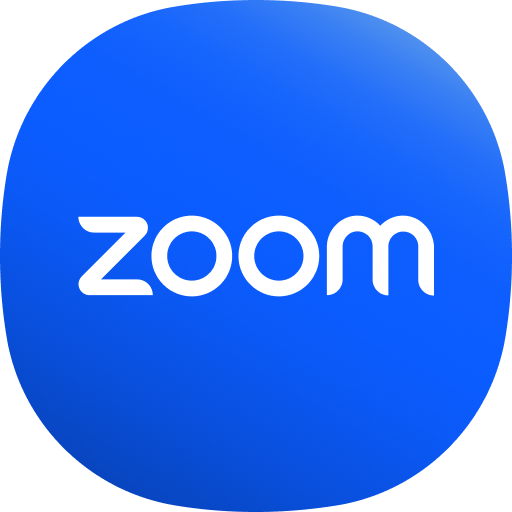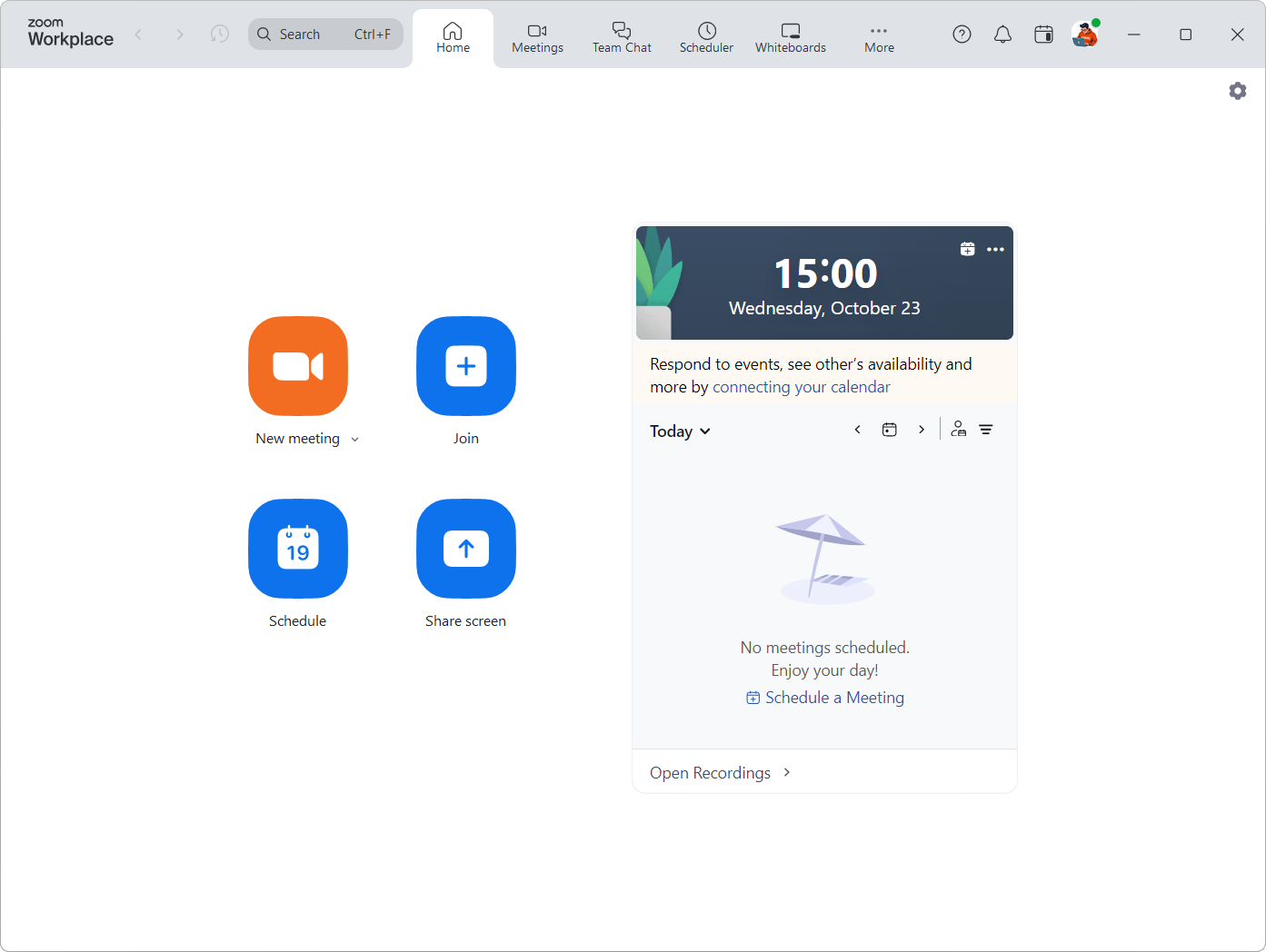 Versie 6.3.10 van de videoconferencingsoftware Zoom Workplace is uitgekomen. Dit programma maakt het mogelijk om onder meer onlinevergaderingen, conferenties en colleges bij te wonen. Het is verkrijgbaar voor de gangbaarste besturingssystemen en is beschikbaar in een gratis en een betaalde uitvoering met meer mogelijkheden. Het programma is ook in het Nederlands te gebruiken. In deze uitgave zijn de volgende veranderingen en verbeteringen aangebracht:
Versie 6.3.10 van de videoconferencingsoftware Zoom Workplace is uitgekomen. Dit programma maakt het mogelijk om onder meer onlinevergaderingen, conferenties en colleges bij te wonen. Het is verkrijgbaar voor de gangbaarste besturingssystemen en is beschikbaar in een gratis en een betaalde uitvoering met meer mogelijkheden. Het programma is ook in het Nederlands te gebruiken. In deze uitgave zijn de volgende veranderingen en verbeteringen aangebracht:
AI Companion featuresMeeting features
- All UI elements, including hero prompts, buttons, system messages, and category responses are localized for supported languages. The UI layout adapts to accommodate varying text lengths across different languages. This allows users to interact with the AI Companion panel in their preferred language, enhancing the overall user experience. The currently supported languages are:
- English
- Chinese (Traditional/Simplified)
- French
- German
- Japanese
- Portuguese
- Spanish
- Italian
- Korean
- Indonesian
- Polish
- Russian
- Swedish
- Turkish
- Vietnamese
- Dutch (Netherlands)
- Users can access AI Companion from additional tabs in the Zoom Workplace mobile app, including Whiteboards, Notes, Clips, Workspace, Apps, and Events. The AI Companion icon appears in the navigation bar on the right side of these tabs. The icon launches the AI Companion screen where users can interact with the AI Companion smart assistant. While this releasee focuses on accessibility across mobile tabs, specific content support for each tab will be added in future updates. The expanded AI Companion integration provides users with convenient access to AI assistance throughout their mobile app experience.
Team Chat features
- Users joining a meeting will consistently see the new simplified preview dialog. This screen displays the selected audio and video sources, the default audio join method (computer audio), and an option to configure their name. Users can easily view and change these settings before joining the meeting so they are properly heard and seen.
- Meeting participants can request access to recordings directly from the meeting card or recording link without having to send separate messages through chat, email, or calls. Meeting hosts receive these requests through in-product notifications and emails, which direct them to a viewing page where they can manage access permissions. Hosts can view all requesters on the share modal, grant or deny access, and manage existing permissions for specific users. The feature respects all security settings, including authentication requirements and password protection.
- After a meeting ends, a dynamic pop-up appears, based on the assets utilized during the meeting, directing users to the meeting details page. Here, they can access available meeting assets such as meeting recording, summary, continuous chat log, as well as any content shared during the session, such as whiteboards, links, and notes.
- Hosts and co-hosts can spotlight a shared item to direct participants' attention to it during meetings. They can select a shared item and mark it as spotlighted so participants know which content to focus on among multiple shared items. Only one shared item can be spotlighted at a time. If a spotlighted share stops, no shares will be spotlighted until a host or co-host spotlights another share. This feature helps hosts manage participant attention so they are focused on the right content.
Clips features
- The forwarded message feature in Team Chat now retains the original rich text formatting and includes attribution details such as the original channel, author name, and timestamp. Users can also add a note with rich text formatting in the forward modal before forwarding the message. Additionally, the forwarded message contains a deep link to the original message, allowing users to access the conversation context. This enhancement ensures that forwarded messages maintain their original formatting and context, improving the overall communication experience. Note: Message attributes from private chats and channels are hidden.
Phone features
- Users can generate a Clip by simply selecting from a library of avatars and adding a transcript, removing the need to schedule unnecessary meetings and helping users communicate effectively even when in different time zones. Users can also change the virtual background of their avatar video before finalizing it, so that the video fits the visual style or context they need. Additionally, users can view a detailed breakdown of their avatar generation usage, showing how many minutes were used per video. Note: This feature will not be immediately available, as it is dependent on a backend release, currently scheduled for February 28, 2025.
Contact Center features
- Account owners and admins can enable a policy to hide Zoom Phone calls from appearing in the iOS and iPadOS device call history. The policy sets the default value of Hide phone calls in device call history to on, preventing Zoom Phone calls from being added to the device's Recents list. This setting applies only to devices with CallKit enabled, and admins can lock the setting to prevent users from making changes. Users can hide Zoom Phone calls from appearing in the call history of their iOS/iPadOS devices. This setting can be enabled under the Phone settings in the Zoom Workplace app. This allows them to maintain separation between personal and professional calls on their mobile devices.
- Account owners and admins can select up to 100 outbound caller IDs for their organization on the Zoom web portal. This feature limits the number of outbound caller IDs shown. When enabled, users will only see the selected outbound caller IDs in their Zoom app interface. Any extensions with more than 100 outbound caller IDs will not be displayed on the app. The system processes caller ID lists with display indicators to control visibility in the user interface. This enhancement improves caller ID organization and makes it easier for users to select the appropriate numbers for outbound calls.
- Account owners and admins can configure one push to talk channel as the default option for each site in their organization. Users who belong to multiple sites with default channels must manually select their channel, and admins receive notifications about potential member conflicts. The system supports channel management across mobile platforms and provides insights through telemetry tracking of account enablement, channel counts, and user distribution. This automated channel connection feature simplifies the push to talk experience for organizations with front-line workers using Zebra devices and other mobile platforms.
Revenue Accelerator features
- Zoom Contact Center now supports emergency calling for agents and supervisors, enabling them to dial 911, 112, and other emergency service numbers directly through the Zoom Contact Center dialpad. When an emergency number is dialed, the Zoom Phone dialer will automatically open and connect the call using the Zoom Phone emergency services configuration. This integration ensures that agents and supervisors can quickly reach emergency services without needing a separate phone.
Note: This feature requires a minimum client version of 6.3.10 for Windows and 6.4.0 for Mac. This feature must be enabled by Zoom.- Supervisors can take over email engagements from agents they manage within Zoom Contact Center. When taking over an engagement, supervisors can view the complete email thread and any draft replies before assuming control. The system notifies agents when their email engagement is reassigned to a supervisor. This enhancement enables supervisors to provide direct assistance for complex customer interactions through the email channel.
- Account owners and admins can enable media redirection to PCI Pal for secure payment processing during voice engagements. During an active call, the agent enters a unique code automatically generated by the payment application, redirecting media to PCI Pal for secure handling. This integration supports native, PWA, and CTI clients, allowing businesses to process payments securely while maintaining PCI compliance within their existing CRM workflows. This feature must be enabled by Zoom.
- Agents can now see consumers' actual name instead of the generic Consumer label in the Zoom Contact Center interface during video engagement. The system displays names based on available information, prioritizing the preferred name, then the first and last name combination, first name only, or last name only. These names appear in agent ringing notifications, profile tabs, the active sections of the left navigation, and engagement headers. This update enables agents to deliver more personalized service by clearly identifying the consumers they are assisting.
- Agents and supervisors can opt in or out of all queues at once in Zoom Contact Center. This feature allows agents who are part of multiple queues across different channels to manage their participation more efficiently, saving time for both agents and supervisors when handling queue assignments.
Resolved issues
- Users can access and review conversation recordings on their mobile devices through the Zoom Revenue Accelerator (ZRA) Conversations tab in the Zoom mobile app. The mobile app allows key activities and call playback, providing sales leaders and customer relationship owners (CROs) with the ability to review crucial customer interactions from their mobile devices. Users can see and reply to existing comments, as well as enter new comments. Users can share recordings and update sharing permission settings.
They also have the ability to add calls to playlists, access playlists, and share playlists. This feature enhances mobility and productivity for sales teams, enabling them to stay up-to-date with critical conversations and make informed decisions regardless of their location. Note: This feature will be rolled out to accounts over time and will be generally available on February 28, 2025.
- Minor bug fixes
- Security enhancements
- Resolved an issue where the Zoom Workplace app 6.1.5 would crash unexpectedly
- Resolved an issue where clicking a Zoom App link in a browser did not open the app properly if Zoom was already running
- Resolved an issue where the Zoom app would close unexpectedly when adding an additional account
- Resolved an issue where the Zoom Workplace app would auto-update during a call, causing the call to drop
- Resolved an issue where the Zoom Calendar displayed events that did not exist
- Resolved an issue where clicking the Refresh button in calendar view resulted in error 100000401
- Resolved an issue where updated Team Chat chatbot messages did not automatically scroll into view, requiring users to scroll manually
- Resolved an issue where in-meeting chats were not being automatically saved locally
- Resolved an issue where users on the allow list could not send messages in the announcement channel
- Resolved an issue where users could not manually type an external member's email address to add them to a Team Chat channel, but copying and pasting worked
- Resolved an issue affecting a subset of users where using AI Companion 2.0 hero prompts, such as Summarize this meeting , from the Workplace App Home tab resulted in a null output


:strip_exif()/i/2007014202.png?f=thumbmedium)